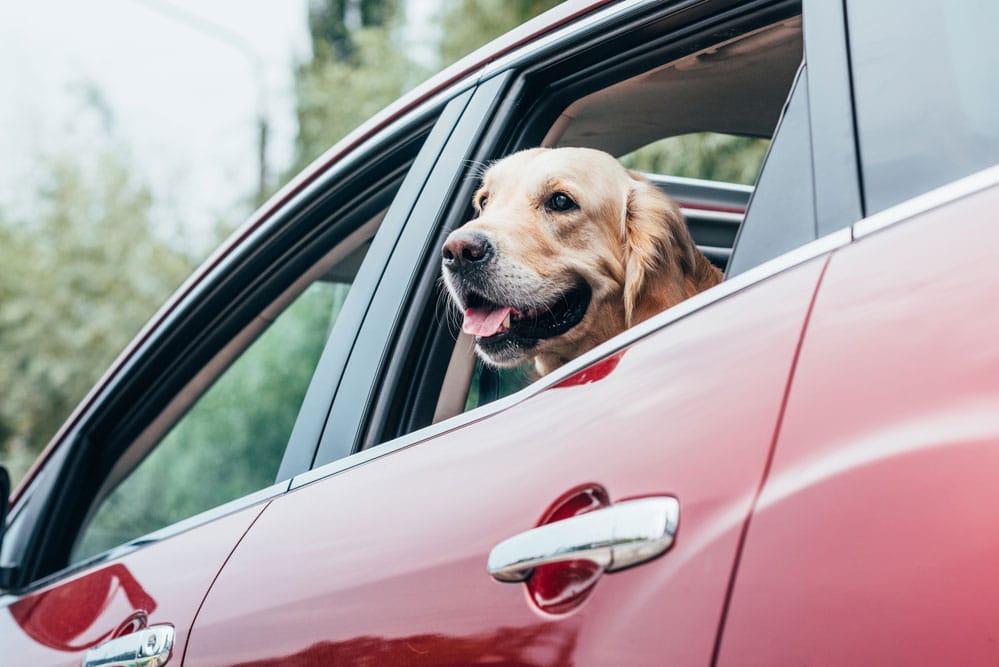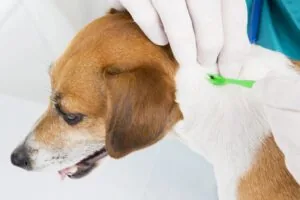Summer Traveling with your Pets

For some pet parents, a trip is no fun if the four-legged members of the family can’t come along. But traveling can be highly stressful, both for you and your pets. If you’re planning to take a trip with pets in tow, we have some tips to help ensure a safe and comfortable journey for everyone. We got thinking about things that make for a good road trip with pets, from the right accessories, to things to bring and trip planning. Here are some tips for safely and enjoyably taking the critters on the road.
Plan ahead
As much fun as it can be for both the pet and the family to bring Fido or Snowball along on a trip, traveling with animals generally requires a bit more planning. If you’re staying in hotels, make sure they’re pet friendly before you book. And keep in mind that some hotels and motels that say they allow animals may have weight limits. If you have a 200-pound Mastiff, make sure you let your hosts know ahead of time. If you’re traveling across state lines, bring along your pet’s rabies vaccination record. While this generally isn’t a problem, some states require this proof at certain interstate crossings.
What to bring
Pack all your supplies in a zippered tote. If you travel often with pets, some of this stuff can just be stored in the tote at home. If you have more than one pet, the best bet is to bring a separate tote for each one. That way, you can keep their food, medications, and toys organized. Some suggestions for the tote include:
Pet friendly guide book
For tips on lodging, pet stores, emergency services, and pet friendly parks along the way. Also check out websites like petfriendly.com and petswelcome.com.
Collar ID Tag
Get one with your pet’s name, your name, and your telephone number. A cell number is best for the road, or you can tape a local number to the collar. Bring along your own vet’s number, too. The best permanent identification is to make sure your pet is microchipped. Be sure before a trip to make sure microchip information is up to date with your name, phone number and any relevant contact information
Pre-packaged food
Bring along your pet’s usual food, and prepack each meal in a Ziplock bag. Familiar food is good for your pet on the road, and can save money over buying as you go. Packing by serving is less messy and more convenient. If you have more than one pet, label each one’s food separately, and always bring spares in case you get stuck.
Water Bowl/Container
Any plastic bowl will do, but a number of sources offer specialty travel bowls.
Leash
It should be obvious, but don’t forget the leash.
Animal Records/Vaccinations
Don’t leave home without them.
Medications
Don’t forget any pills, ointments, or anything else you give your pet at home.
Plastic bags
For cleaning up after your pet.
Litter and box
If you’re traveling with a cat.
Pet carrier
For cats and smaller dogs.
Cleaning supplies
In case there’s an upset stomach or “accident” on the road.
For your vehicle
Pet barrier
Available in a variety of sizes for wagons, minivans, or SUVs, a barrier gives your pet some room to move, but keeps them safely contained behind the rear seat and off the upholstery.
Harness/restraint
As you plan your road trips this summer, be sure to consider your pet’s car safety before pulling out of the driveway. With states like Hawaii, Connecticut, Illinois, and Maine banning motorists from driving with their pets in their laps and New Jersey debating a law that would require pets to wear seat belts. For the safety of your pet and your family, look for a harness that lets your pet sit or lie down, but will keep them restrained in an accident.
Cargo area mat or liner
Mats and liners help protect carpets and make cleanup easier. Look for one with a 2-3 inch lip around the edge to keep spills contained.
Mat/travel bed
If you have a pet bed at home, you can bring it along to help keep your pet comfortable and make them feel more secure. Or get one just for your car. Beds for the cargo area are one option, as are hammocks that fit over the rear seat area.
Water bowl
A resealable container is fine, but you can find ones that are collapsible, spillproof, or both. One cool model from BarkBuckleUp.com fits in a cupholder.
Loading ramp
Smaller and older dogs can more easily get in and out using a ramp, and it makes loading easier on your back, too. A variety of models and sizes are available. Telescoping or foldable models provide extra length without being too long to fit in your car.
While on the road
Stop every couple of hours to let your pet take a break and have some water. Prep your pet for a long trip. Get your pet geared up by taking him on a series of short drives first, gradually lengthening the time spent in the car.
Never let your pet ride with its head out the window – eye, ear, and head injuries could result.
Always put your pet on the leash before opening the door or tailgate to let them out.
Keep your pets safe and secure in a well-ventilated crate or carrier. The crate should be large enough for your pet to stand, sit, lie down and turn around in. Secure your pet’s crate so it will not slide or shift in the event of an abrupt stop. If you decide to forgo the crate, don’t allow your pet to ride with his head outside the window, and always keep him in the back seat in a harness attached to a seat buckle.
Never leave your animal alone in a parked vehicle. On a hot day, even with the windows open, a parked automobile can become a furnace in no time, and heatstroke can develop. In cold weather, a car can act as a refrigerator, holding in the cold and causing the animal to freeze to death.
Veterinary Tips
Make a travel litter box. For trips over 6 hours, provide a litter box for cats. This can be made from a small cake pan or small cardboard box filled with litter.
Give your dog a new toy for travel. The novelty of “new” will entice your dog to pass the time playing with its new toy.
Exercise your dog prior to a long trip. A tired dog will be less anxious and nervous due to the stabilization of the brain chemicals responsible for stress.
Take your dog for a walk as soon as you arrive at your destination.
Bring recent vaccination and medical records. Should your pet become ill, these documents can save valuable time and expense.
Bring a photo. It’s a good idea to carry a recent picture of your pet. The easiest way is to take one with your phone, or bring a print. If you get separated from your pet, a picture is really worth a thousand words.
Many pets experience nausea, anxiety and stress when riding in cars. Both natural remedies and conventional medications are available. Talk to your veterinarians about your options.
Traveling by plane?
Unless your furry friend is small enough to ride under your seat, it’s best to avoid air travel with your pets. If you must bring your pet along on the flight, here are a few suggestions to keep your pet safe while flying the friendly skies.
Book a direct flight whenever possible. This will decrease the chances that your pet is left on the tarmac during extreme weather conditions or mishandled by baggage personnel during a layover.
Make an appointment with your pet’s veterinarian for a checkup. Prior to your trip, make sure your pet’s vaccinations are up-to-date and obtain a health certificate from your veterinarian dated within 10 days of your departure. Tranquilizing your pet is generally not recommended as it could hamper his or her breathing, so use this time to check with your veterinarian for ways to relax your pet if you suspect he or she may become afraid, anxious or uncomfortable mid-flight. For travel outside of the continental United States, additional planning and health care requirements may be necessary. Contact the foreign office of the country you are traveling to for more information.
Purchase a USDA-approved shipping crate. The crate should be large enough for your pet to stand, sit and turn around in comfortably, and lined with some type of bedding—shredded paper or towels—to absorb accidents. Prior to your trip, tape a small pouch of dried food outside the crate so airline personnel will be able to feed your pet in case he or she gets hungry during a layover. The night before you leave, freeze a small dish or tray of water for your pet. This way, it can’t spill during loading and will melt by the time he or she is thirsty. Make sure the crate door is securely closed, but not locked, so that airline personnel can open it in case of an emergency.
Make sure your pet’s crate has proper identification. Mark the crate with the words “Live Animal,” as well as with your name, cell phone and destination phone number, and a photo of your pet. Should your pet escape from the carrier, this could be a lifesaver. You should also carry a photograph of your pet.
Tell every airline employee you encounter—on the ground and in the air—that you are traveling with a pet in the cargo hold. This way, they’ll be ready if any additional considerations or attention is needed. If the plane is delayed, or if you have any concerns about the welfare of your pet, insist that airline personnel check the animal whenever feasible. In certain situations, removing the animal from the cargo hold and deplaning may be warranted.
Share This Post
Recent Posts
About Shallowford Animal Hospital
Shallowford Animal Hospital and The Pet Spa at Shallowford are dedicated to the exceptional, compassionate care your pet deserves. Pets hold a very special place in our families, and we treat yours like our own.



